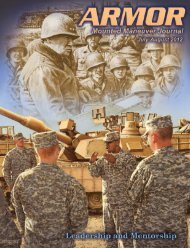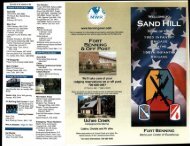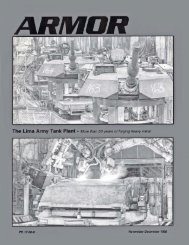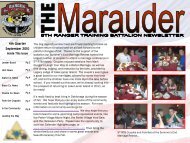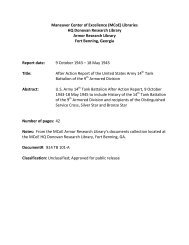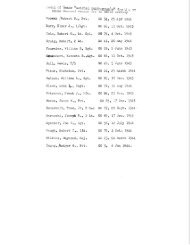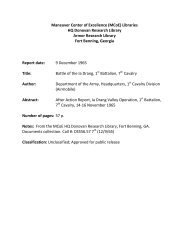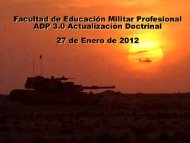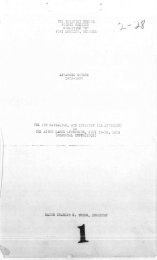ARMOR, September-October 1987 Edition - Fort Benning - U.S. Army
ARMOR, September-October 1987 Edition - Fort Benning - U.S. Army
ARMOR, September-October 1987 Edition - Fort Benning - U.S. Army
Create successful ePaper yourself
Turn your PDF publications into a flip-book with our unique Google optimized e-Paper software.
corps maintenance support intact<br />
for support behind the enemy lines.<br />
While the tactical configuration of<br />
the tank corps depends on many<br />
variables such as combat mission,<br />
fighting strength, width of sector,<br />
enemy defense, and terrain, the<br />
tank corps commander usually<br />
seeks to provide for flexible control<br />
and speed. Based on the informa-<br />
tion concerning the situation, the<br />
commander prescribes a zone six to<br />
eight kilometers wide in the ad-<br />
vance to the line of commitment.<br />
This gives him room to maneuver<br />
the corps. He forms the corps into<br />
two echelons, an artillery group,<br />
and a reserve. Two tank brigades,<br />
with a large proportion of the sup-<br />
port weapons and all the artillery,<br />
formed the first echelon, while ad-<br />
vancing the corps on two axes. The<br />
depth of the columns of the main<br />
forces reached 20-22 kilometers<br />
(see figure 2).<br />
Questions of coordination and pas-<br />
sage of lines with the commanders<br />
of the first echelon rifle corps were<br />
taken up previously on the day<br />
preceding the transition to the offen-<br />
sive. At that time, the brigade com-<br />
mander conducted a reconnaissance<br />
of the routes of advance.<br />
An attached representative from<br />
the supporting air army worked out<br />
aviation support. In coordination<br />
with the operation, the air repre-<br />
sentative planned the air support<br />
for the approach and supporting<br />
strikes once the unit broke into the<br />
operational depth.<br />
For greater flexibility and agility in<br />
signals communications, selected<br />
combat vehicles with cross-country<br />
capabilities were fitted out as main<br />
radio stations and the commanders<br />
and staff run a communications test<br />
before moving out. Communications<br />
within the corps are organized in<br />
the following manner: corps staff<br />
has radio communications with the<br />
subordinate units on two channels;<br />
with staffs of higher headquarters<br />
over three channels; and two sta-<br />
tions for communications nets to<br />
other units and commanders.<br />
The tank corps commander from<br />
his operational group has a radio<br />
station working with the brigade<br />
commanders and a radio station<br />
with the higher commander. Also,<br />
on the corps commander's net with<br />
the brigade commanders is the chief<br />
of staff for the corps, which allows<br />
him to keep informed on orders and<br />
reports from brigade commanders.<br />
The radio nets of the artillery are<br />
organized in a similar manner. The<br />
MOM a<br />
II X Ill<br />
Figure 2.<br />
13thTankCorps:<br />
Two-column commitment to the breakthrough<br />
corps staff maintains separate chan-<br />
nels with reconnaissance and the<br />
rear, and a separate net with the<br />
front line infantry who create the<br />
breach in the lines for the tank<br />
corps. Through radio nets, officers<br />
from the air units assigned to the<br />
corps staff communicate with air<br />
support to direct aircraft to targets.<br />
Under the cover of darkness, the<br />
reconnaissance elements of the first<br />
echelon brigades begin the advance<br />
on their respective axes. The recon-<br />
naissance parties consist of a<br />
platoon of tanks, a section of com-<br />
bat engineers, up to a platoon of<br />
submachine gunners, and armored<br />
vehicles and motorcycles.<br />
The Movement Support Detach-<br />
ment follows behind the reconnais-<br />
sance and begins necessary obstacle-<br />
clearing on the movement routes for<br />
their parent brigades. Approaching<br />
the line of commitment, forward<br />
detachments deploy into combat for-<br />
mations. The corps<br />
receives the signal fr<br />
commander to commit<br />
The Battle<br />
The Corps commander hopes to<br />
have a 'christaya' (clean) break-<br />
through. This means the first-<br />
REAR<br />
SERVlCES<br />
X 111 II<br />
HQ 0 MRL<br />
REAR<br />
SECURlTY<br />
<strong>September</strong>-<strong>October</strong> <strong>1987</strong> <strong>ARMOR</strong> 27



